Introduction to EV charging types and connectors
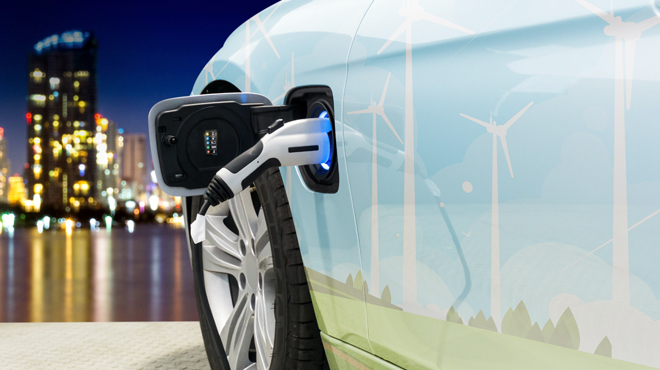
Types of EVSEs
There are many types of EVSE. These are divided into four categories, which are designated Mode 1 to Mode 4. Mode 1, 2 and 3 EVSEs supply AC to the vehicle, while Mode 4 EVSEs, which are used for high-power fast charging, supply DC. Mode 4 EVSEs are the only type where the ‘charger’ is part of the EVSE; for all other types, the charger is in the vehicle. Let’s look at these EVSE types in a little more detail.
Mode 1
This is an AC charging mode that is usually considered to be an emergency provision. The EVSE consists only of a cable that will connect the vehicle to an ordinary, non-dedicated power outlet. The safe implementation and use of this mode relays on the safety of the electrical installation itself. In the UK, the maximum charging power is 3 kW. Since there is no automatic control over the charging function and suitable RCD protection cannot be guaranteed, Mode 1 charging should only be used where no alternative is available. It is, in fact, illegal in many countries.
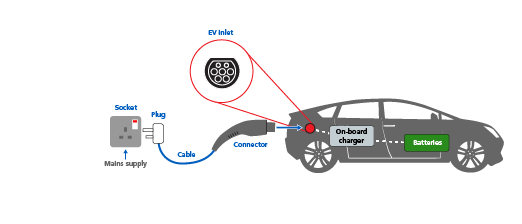
Mode 2
This is an AC charging mode that uses a portable EVSE or a special charging cable that includes control facilities and earth (ground) fault protection. Like Mode 1, it uses an ordinary non-dedicated power outlet, which means that it is limited to a maximum charging power of 3 kW in domestic applications, although higher powers, up to 7.4 kW, may be possible where a 32 A industrial power outlet is available. Mode 2 EVSEs are typically considered entry-level, but they do have the advantage that users can take their EVSE with them when visiting locations where no other charging facilities are available.
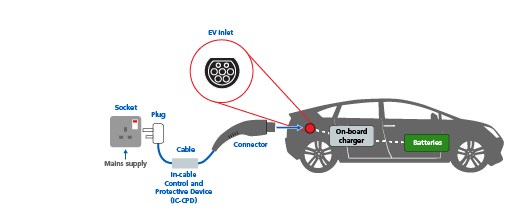
Mode 3
This is an AC charging mode that uses a fixed EVSE, which includes control facilities and earth (ground) fault protection. It is always powered from a dedicated circuit, and depending on the type of supply, it can deliver either single- or three-phase current to the vehicle. Typical charging power is 3.7 kW or 7.4 kW in domestic installations, but it can be much higher – 50 kW or more – in commercial and public applications where sufficient supply capacity is available. At present, this is the most common type of EVSE.
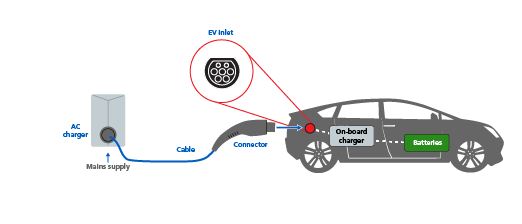
Mode 4
This is a DC mode that uses a fixed EVSE that incorporates the charger (rectifier) system, as well as control facilities and earth (ground) fault protection. It is always powered from a dedicated circuit. Mode 4 chargers are primarily for fast and ultra-fast charging and are often found in public locations such as motorway service areas. The maximum charging power can be 100 kW or more.
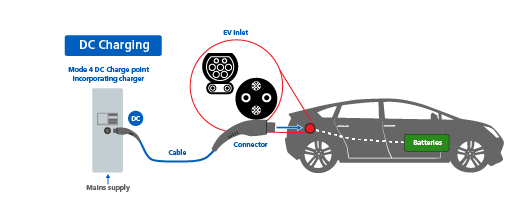
Connectors
Several types of connectors are used to link EVs to the EVSE. One of the most common in Europe is EN 62196-2 Type 1, which is equivalent to North American and Japanese type J1772. This is used with Mode 2 and Mode 3 EVSEs and has a maximum power rating of 7.4 kW single phase. Also common in Europe is the EN 62196-2 Type 2 (Mennekes) connector, which has a maximum power rating of 16.1 kW single phase or 43.7 kW three phase.
For EVSEs that supply DC to the vehicle, the CHAdeMO connector, with a maximum power rating of 100 kW, and the CCS connector, with a maximum rating of 170 kW, are available. In Europe, Tesla vehicles use the CCS connector, but a proprietary connector is used in other markets.
The industrial trend in Europe and the United Kingdom is to implement as standard the Type 2 (Mennekes) and the CCS1 as the only available connectors, while in the USA it will be the NACS (North American Charging Standard which is the equivalent to the Tesla connector.













